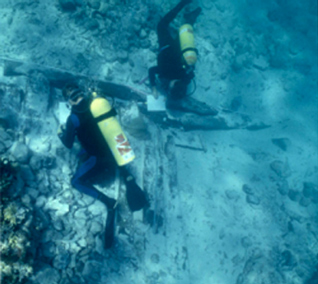The National Park Service and other agencies engage in archeology both on land and under water.
Underwater Search for Scorpion

NPS Photo
In February 1814, the USS Scorpion reported for duty at Baltimore, Maryland, in Commodore Joshua Barney's Chesapeake Bay Flotilla and became the flagship. Barney's fleet engaged the British Navy on several occasions on the Patuxent River and Chesapeake Bay and was able to delay the British advance on Washington DC. The superior British frigates eventually overwhelmed Barney's fleet forcing an American retreat. To avoid allowing Scorpion from falling into British hands, Barney ordered the ship burned at Pig Point near Upper Marlboro in Maryland.
The National Park Service and other agencies engage in archeology both on land and under water. Archeologists with the State of Maryland, the US Navy, and Maryland Historical Trust have searched for the USS Scorpion in the Patuxent River since 1980. Past underwater archaeology surveys revealed a War of 1812 wreck in these waters, but not enough evidence was gathered to identify her as Commodore Joshua Barney's flagship, but by 2010 they think they may have found her. Read the full story at The Search for the USS Scorpion, a blog that documents the underwater archeological survey conducted by the Maryland State Highway Administration, the US Navy, and Maryland Historical Trust.
Learn More
Part of a series of articles titled Preserving the War of 1812 for Future Generations.
Last updated: August 14, 2017
